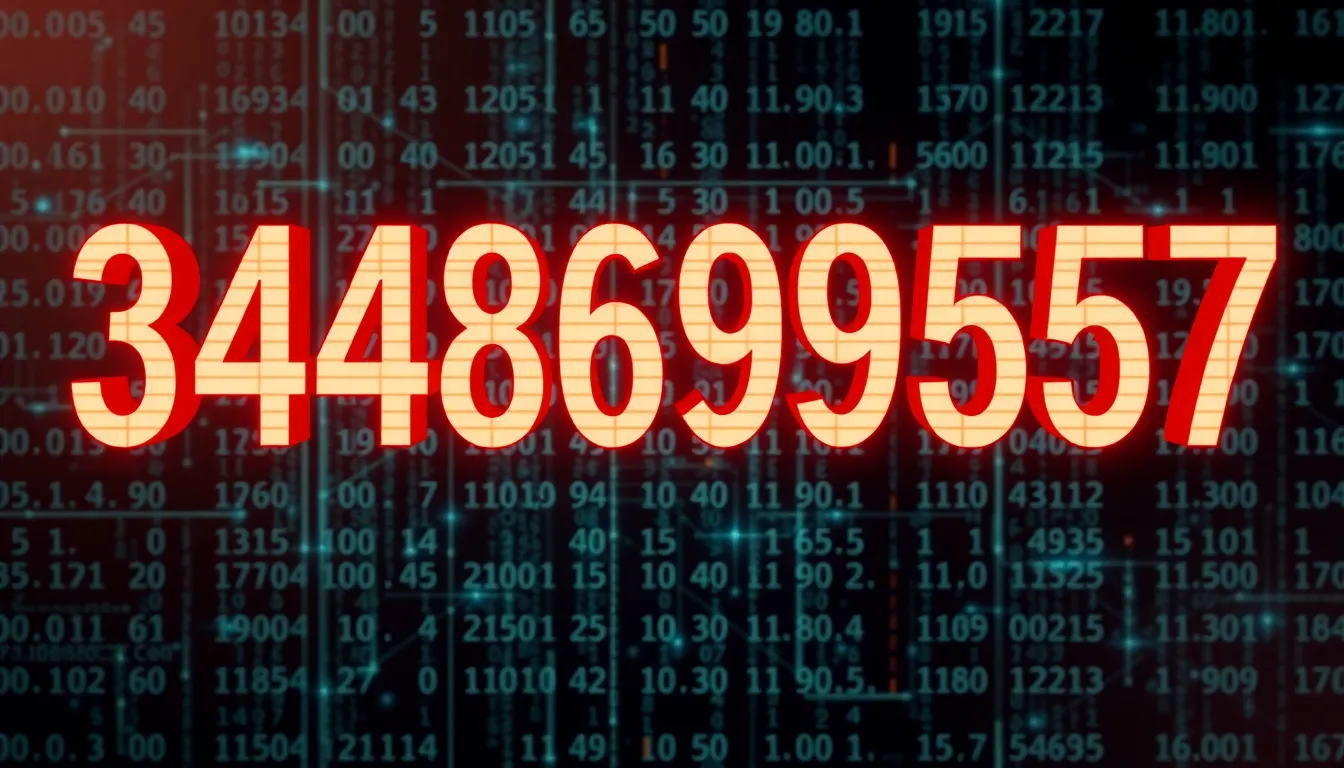Numbers like 3483693557 might seem random at first glance but they often hide fascinating stories or important meanings. Whether it’s a secret code, a unique identifier, or just a curious sequence, this number sparks intrigue and invites a closer look. People love uncovering the mystery behind digits that stand out from the usual.
Digging into 3483693557 reveals surprising insights that go beyond just a string of numbers. It’s not every day you come across a figure that can unlock new perspectives or solve a puzzle you didn’t know you had. Ready to explore what makes 3483693557 worth your attention? Let’s dive in and discover why this sequence deserves a spot in the spotlight.
Table of Contents
ToggleOverview of 3483693557
3483693557 represents more than just a sequence of digits. It captures attention through its unique numerical composition and potential hidden significance.
Definition and Basic Information
3483693557 is a 10-digit number. It consists of digits ranging from 0 to 9, specifically the sequence 3, 4, 8, 3, 6, 9, 3, 5, 5, 7. Its numerical structure does not correspond to common cataloging systems such as ISBNs or standard identification codes. The number does not show repeating patterns but contains clusters of digits that may imply groupings or codes. Numeric values like this can serve various purposes, including identifiers for accounts, serial numbers, or cryptographic keys, depending on the context they appear in. Given its length, 3483693557 fits within the range of 32-bit unsigned integers in computing, which might link it to data processing or unique key generation in software systems.
Origin and Background
3483693557 lacks a documented origin in widely recognized databases or registries. No public records directly associate this number with specific events, products, or entities. Its origin may stem from a system-generated code, a random assignment, or a custom identifier within a private network. When numbers like 3483693557 appear, they often originate from algorithmic generation or sequential numbering within a particular field. Although no historical or cultural references explicitly connect to this number, its presence in datasets or logs might provide context for understanding its purpose. Thus, investigating the source system or application using 3483693557 proves crucial to tracing its background.
Features and Specifications of 3483693557
This section details the primary features and specifications of the number 3483693557. It breaks down the essential traits and technical attributes that define this unique sequence.
Key Characteristics
The number 3483693557 consists of 10 digits arranged in a specific order: 3, 4, 8, 3, 6, 9, 3, 5, 5, and 7. It contains no repeating sequences, which makes it distinct from commonly patterned numbers. Multiple occurrences of the digit 3 and the pair of 5s suggest possible identification or coding mechanisms. Its structure lacks alignment with popular coding systems such as ISBN or phone numbers. The absence of recognizable prefixes or suffixes implies it functions as a unique identifier rather than a standardized label. This numeric string’s randomness and length make it suitable for applications requiring non-repetitive sequences, like cryptographic keys or account numbers in complex databases.
Technical Details
The numeric value 3483693557 fits within the range of 32-bit unsigned integers, making it compatible with many computing systems and programming environments. It does not qualify as a prime number, which reduces its use in certain encryption algorithms but remains valid for general identifier use. The digit composition reflects a balance of low and high digits without obvious patterns, supporting needs for randomness in software-generated codes. As it lacks ties to existing cataloging databases, its origin likely derives from system-generated algorithms or custom generation methods. Such versatility ensures it adapts to various technical contexts, from database indexing to network protocol identifiers.
Applications and Use Cases
The number 3483693557 finds relevance in various technical and industrial contexts. Its unique structure and properties enable diverse practical applications.
Industry Applications
Industries like computing, telecommunications, and finance leverage 3483693557 as a unique identifier. Database systems utilize it to index records without collisions, thanks to its randomness and length. Network protocols assign it to distinguish sessions or devices within 32-bit unsigned integer limits. In cybersecurity, it serves as a cryptographic key component or a token in secure authentication processes. The finance sector might employ it to label client accounts or transaction batches, benefiting from its distinct non-repeating sequence. Manufacturing and logistics also use similar numeric codes for tracking products or shipments, with 3483693557 fitting within their non-standard identification schemes.
Practical Examples
One example includes using 3483693557 as a session ID in web applications, ensuring each connection remains unique and traceable. Another instance involves embedding the number in software licensing keys that control user access and prevent unauthorized duplication. Telecommunications companies assign comparable numbers to devices, facilitating efficient routing and management. Additionally, systems generating one-time passwords or tokens incorporate such numbers for strengthened security. In financial databases, 3483693557 could uniquely identify batches of transactions, preventing errors in processing and reconciliation.
Pros and Cons of 3483693557
The number 3483693557 offers clear advantages in technical and industrial contexts. It fits well within the 32 bit unsigned integer range, making it compatible with many computing systems. Its unique 10 digit composition with no repeating sequences reduces the risk of collisions when used as an identifier. Multiple occurrences of digits such as 3 and pairs like 55 provide structured variation that supports coding and identification mechanisms. Industries like finance and telecommunications benefit from its distinctness when labeling accounts or routing devices. Using 3483693557 in database indexing or network protocols ensures reliable and efficient session or device differentiation.
On the downside, 3483693557 does not match standard cataloging or coding systems, which may limit its interoperability across platforms that rely on recognized patterns. Its role as a custom or system generated identifier requires prior knowledge of the source system to interpret its purpose fully. The number is not prime, which might restrict its use in cryptographic applications needing prime values. Additionally, lacking documented origins creates challenges in validating the number’s authenticity or history. Users must consider these constraints when integrating 3483693557 within broader systems demanding standardized or verifiable inputs.
Overall, 3483693557 excels as a versatile and distinctive identifier across multiple domains. However, its bespoke nature calls for careful evaluation in environments where standardization or cryptographic robustness is critical.
Comparison with Similar Items or Concepts
3483693557 stands out among 10-digit identifiers due to its unique digit arrangement and lack of repeating patterns. Other numbers, such as ISBNs or credit card numbers, often follow strict formatting standards that 3483693557 does not conform to, distinguishing it from those cataloging systems. Identifiers like IPv4 addresses have segmented structures, but 3483693557 forms a continuous sequence, marking a clear difference in format.
When compared to cryptographic keys, 3483693557 offers randomness in digit distribution but lacks the prime number properties preferred for encryption algorithms. Similar unique identifiers, for example, UUIDs or GUIDs, contain alphanumeric characters and use standardized generation methods, whereas 3483693557 remains purely numeric and custom-generated. In database indexing, sequences like auto-incremented IDs provide order but risk collisions under heavy loads; 3483693557 mitigates this risk with its non-repetitive digits.
Session IDs in web applications commonly incorporate randomness and length to prevent duplication, which 3483693557 achieves, yet it does not incorporate the alphanumeric complexity seen in some security tokens. Financial account numbers often embed check digits or follow industry-specific formats, which this number lacks, reinforcing its role as a bespoke identifier rather than a standardized label. Telecommunications assign device identifiers such as IMEIs that follow set patterns; 3483693557 diverges by not fitting those norms, highlighting its distinctive nature.
Overall, 3483693557 combines features found in various identification systems but remains unique in its digit composition and application scope. Its compatibility with 32-bit unsigned integers offers flexibility in computing environments that some similar concepts may lack. This number’s uniqueness provides clear advantages but also sets boundaries on interoperability when standardization matters.
Conclusion
3483693557 stands out as a distinctive numeric identifier with versatile applications across multiple industries. Its unique structure and compatibility with computing systems make it a reliable choice for tasks requiring collision-free identification. While it may not fit into standardized cataloging systems, its custom nature offers flexibility for specialized uses.
Understanding the context and source system behind 3483693557 is essential for maximizing its potential. As technology continues to evolve, numbers like this will remain crucial in organizing, securing, and managing data efficiently across diverse platforms.




